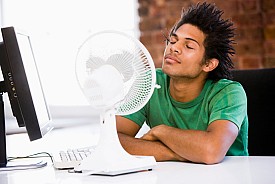Simple Weatherizing for Summer
 Weatherizing a home to reduce energy usage and maximize savings is something homeowners think about in cold weather. The fact is, energy efficiency is just as important during summer months, and simple improvements can make a big difference in your budget as well as increase comfort by keeping your home cooler and lowering the demand for air conditioning. Best of all, these simple tasks can be completed quickly.
Weatherizing a home to reduce energy usage and maximize savings is something homeowners think about in cold weather. The fact is, energy efficiency is just as important during summer months, and simple improvements can make a big difference in your budget as well as increase comfort by keeping your home cooler and lowering the demand for air conditioning. Best of all, these simple tasks can be completed quickly.
Caulking doors and windows: Air leakage is a serious problem, wasting as much as 30% of energy usage, moving both hot and cold air through small leaks and cracks in a building. Doors and windows are one of the most significant areas of loss. Running a bead of caulking around interior and exterior doors and windows will create a seal to minimizing air flow, keeping cool air in and hot air out. Buy high quality caulk, and it will be many years before you need to remove and replace it. If you don’t have a steady hand, ask a hardware specialist for assistance in picking out a clear caulk (that will minimize mistakes) and purchase an inexpensive caulking tool to help you apply a straight bead. For more information, read "Air Sealing in Hot, Humid Climates", which was written by an Atlanta HVAC expert.
Replace worn door sweeps and tighten up the jamb: Drafty doors suck up all your hard-earned money and get overlooked, but high traffic causes door sweeps to wear down quickly and weather-stripping to flatten out. There are several types of door sweeps available, most available at an average cost of $10-13. Most come in standard door sizes but can be customized if necessary. None require installation expertise beyond knowing how to use a screwdriver, or a small hacksaw if they need to be cut to size.
Sweeps are typically used for exterior doors, but if you have an infrequently used interior room (e.g. guest room) or a basement door leading to a den or man cave, putting a door sweep on those doors can make heating and cooling more energy efficient. Why use energy in unused spaces? Closing off those rooms through use of a sweep will enable you to keep the rest of your home at a more stable temperature.
After installing door sweeps, remove old weather-stripping from door jambs. For reluctant DIY-ers there are several replacement products available, from self-sticking foam tapes to V-seal or P-shaped silicon bulbs. They range in price from $4 to $11. Instructions for application are included in most packaging. Several manufacturers have online videos to help walk you through this very low-tech repair.
Insulate outlets and switches: Air leaks from attics and basements can travel through interior and exterior walls. Applying foam sealers to ALL receptacles and switches in a home is the easiest way to save. Cost for an average home? Less than $40, but you can realize savings up to 20% in energy use. Application is simple: Remove the screw attaching the outlet/switch covers, push the foam cutout over the outlet/switch. Before replacing the cover, check for open spaces around the outlet/switch boxes and use a spray foam insulating product to fill open areas (around the perimeter only). Follow the manufacturer’s instructions for usage and use sparingly, as spray foam expands.
Use room darkening shades and fans: Being aware of your environment and how heating and cooling are affected by weather is the single biggest way to save money. Try weatherizing through strategic utilization of shades and fans. Install room-darkening shades or drapes in windows on the sunniest side of the house and pull them down in peak sunny hours to keep internal temperatures stable. Fans help to keep temperature balanced. Since they use less energy than air conditioners, can also keep you comfortable during cooler evenings.
All of these weatherizing improvements are low cost and can be completed in a weekend, but the savings and comfort will be appreciated for years. For information about available rebates for energy saving products or to download “A Guide To Energy Efficient Cooling & Heating” visit Energy Star. .
Laura Foster-Bobroff is a former remodeling contractor. She wrote this article for Networx.com.
Looking for a Pro? Call us (866) 441-6648

Electrical Average Costs
Electricians Experiences

Neglecting A Leak Led To A Roof Replacement

Fast Air Conditioning Repair Helps Us Beat Atlanta’s Summer Heat



